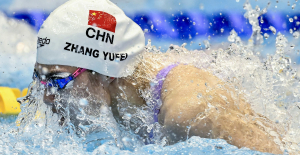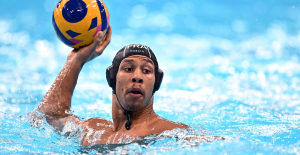Paula von Lamberg would be proud if she were still able to experience what is happening in the sport for which she once did pioneering work. That was in 1911, captured in a photo on a historical postcard. In a long skirt and with an upright posture, she seems to be floating through the Alpine panorama. The fact that she landed again after 22 meters is neither to be guessed nor relevant for the retrospective. Her jump on the "Großer Kitzbüheler Hügel" is still considered a milestone in women's ski jumping, although von Lamberg was by no means the first lady to dare to descend a hill on two skis.
The jump earned her the nickname "the flying countess" due to her membership in the Austrian nobility. Although "jumping countess" would actually have fitted better if you compare the distance measured back then with those that will be set up this weekend. The flying queens of the present are Eva Pinkelnig, Ema Klinec, Selina Freitag and Katharina Althaus. 112 years after von Lamberg, they will take women's ski jumping to new dimensions with the first ski flying event in history.
Unlike in the annals of their young sport, in which the women usually line up behind the men and had to fight their way to new distances in small jumps, this time they start out big. It goes straight to the awesome “Monsterbakken” in Norwegian Vikersund, together with the facility in Slovenian Planica the largest ski jump in the world. This is where Stefan Kraft set the world record of 253.5 meters six years ago. The women now want to achieve similar distances when they are guests on Sunday at the end of the Raw Air Tour, the Scandinavian counterpart to the Four Hills Tournament.
The statements of the jumpers show the importance of this competition. "That's the biggest goal this year. Not the World Cup," said Norway's top jumper Maren Lundby of the local newspaper "Verdens Gang". For Germany's best athlete Althaus it is even the fulfillment of a childhood dream. The woman from Oberstdorf had formulated three of these. Number one, participation in the Olympic Games, was already fulfilled in 2014 at the first performance of women's jumping in Sochi. Number two, the participation in a Four Hills Tournament that is equal to the men, the introduction of which has long been a consensus, but above all still fails due to the hesitation tactics of the Austrian association, is still pending. That won't happen before the 2024/25 season. But number three, ski flying, which has been reserved for men in the World Championships and World Cup since the 1970s, is imminent.
“I was able to experience that as a child in Oberstdorf. It's just even more fascinating when you can fly further than 200 meters," says Althaus to WELT. It is the dream of flying, the rush of gliding, that unites this crazy species of adrenaline junkies. Markus Eisenbichler once described the eight seconds in the air as "almost as good as sex".
It is the last challenge in a ski jumper's life. And the circle of jumpers who are allowed to face this is deliberately kept small. In addition to Althaus, the 14 other athletes who are ahead in the overall standings of the Raw Air Tour after eight of the nine individual tests will start. Flying is reserved for the absolute elite for the time being. "It's the right decision. Right now at the beginning at the premiere. In the Raw Air Tour we only jump on large hills - that's how you know with the top 15 that they can actually ski fly without any problems," says Althaus, who is second in the Raw Air classification after her victory in Lillehammer.
The risk of something going wrong due to less experienced jumpers should be kept as small as possible. After all, Althaus' analysis that "the movement is no different" than in jumps from normal and large hills applies. The speeds - about 110 km/h when jumping and 130 km/h in the air - are different. And with it the danger that any falls have bad outcomes. The Norwegian Daniel André Tande serves as a deterrent example, who had to be put into an artificial coma after a fall in Planica in 2021.
The women - aware of the possible danger - do not want to be banned. They had had to wait too long again. In 2021, the international ski association FIS decided 9:7 against the introduction of women's ski flying in its decisive committee. It was not until the following year, and after the incomprehension of many athletes, that the decision-makers voted 14:0 for the introduction. You are allowed to fly, despite the doubters.
Among them is Toni Innauer, the Austrian jumper legend. The former ZDF expert sent a public letter to the FIS in July last year. In it, he complained that "physical-biomechanical connections and differences and the resulting danger are negligently negated and that the focus is on a gender equality debate". Women are "less resilient due to the gender-specific lower proportion of muscle in the total body weight". Now he followed up, spoke of the "worst case that will happen over the years - with 100 percent certainty."
Resilience - if not on a muscular level - is actually in the nature of ski jumpers, because in the past they had to break through enough headwinds. At the end of the 1990s, when the then FIS General Secretary Gian-Franco Kasper used the argument against women ski jumping that they could “tear their wombs when they land”. Heading towards the 2010 Winter Games in Vancouver, when they unsuccessfully tried to sue for their participation. And now with the tough advertising for ski flying. "I'm really happy that it's finally here. That we can fly. That we are finally allowed to do so," says Althaus.
While women are still fighting for their recognition in other winter sports disciplines, above all Nordic combined, the ski jumpers have largely made it through their perseverance. “You no longer feel out of place. We belong. I am pleased that our performance is now appreciated,” says Althaus.
The four-time medal winner of the Planica title fights now approaches her latest task in Vikersund with the necessary mixture of anticipation and humility. "I'm definitely going to be very nervous when I'm up there, but I'm not scared. Respect for sure. If I were scared, I wouldn't be allowed to fly," says Althaus. Because if thermal is the ski jumper's friend, fear is the natural enemy. It forces athletes to make mistakes. And it is important to avoid that when ski flying.

 Hamas-Israel war: US begins construction of pier in Gaza
Hamas-Israel war: US begins construction of pier in Gaza Israel prepares to attack Rafah
Israel prepares to attack Rafah Indifference in European capitals, after Emmanuel Macron's speech at the Sorbonne
Indifference in European capitals, after Emmanuel Macron's speech at the Sorbonne Spain: what is Manos Limpias, the pseudo-union which denounced the wife of Pedro Sánchez?
Spain: what is Manos Limpias, the pseudo-union which denounced the wife of Pedro Sánchez? Spain is the country in the European Union with the most overqualified workers for their jobs
Spain is the country in the European Union with the most overqualified workers for their jobs Parvovirus alert, the “fifth disease” of children which has already caused the death of five babies in 2024
Parvovirus alert, the “fifth disease” of children which has already caused the death of five babies in 2024 Colorectal cancer: what to watch out for in those under 50
Colorectal cancer: what to watch out for in those under 50 H5N1 virus: traces detected in pasteurized milk in the United States
H5N1 virus: traces detected in pasteurized milk in the United States Private clinics announce a strike with “total suspension” of their activities, including emergencies, from June 3 to 5
Private clinics announce a strike with “total suspension” of their activities, including emergencies, from June 3 to 5 The Lagardère group wants to accentuate “synergies” with Vivendi, its new owner
The Lagardère group wants to accentuate “synergies” with Vivendi, its new owner The iconic tennis video game “Top Spin” returns after 13 years of absence
The iconic tennis video game “Top Spin” returns after 13 years of absence Three Stellantis automobile factories shut down due to supplier strike
Three Stellantis automobile factories shut down due to supplier strike A pre-Roman necropolis discovered in Italy during archaeological excavations
A pre-Roman necropolis discovered in Italy during archaeological excavations Searches in Guadeloupe for an investigation into the memorial dedicated to the history of slavery
Searches in Guadeloupe for an investigation into the memorial dedicated to the history of slavery Aya Nakamura in Olympic form a few hours before the Flames ceremony
Aya Nakamura in Olympic form a few hours before the Flames ceremony Psychiatrist Raphaël Gaillard elected to the French Academy
Psychiatrist Raphaël Gaillard elected to the French Academy Skoda Kodiaq 2024: a 'beast' plug-in hybrid SUV
Skoda Kodiaq 2024: a 'beast' plug-in hybrid SUV Tesla launches a new Model Y with 600 km of autonomy at a "more accessible price"
Tesla launches a new Model Y with 600 km of autonomy at a "more accessible price" The 10 best-selling cars in March 2024 in Spain: sales fall due to Easter
The 10 best-selling cars in March 2024 in Spain: sales fall due to Easter A private jet company buys more than 100 flying cars
A private jet company buys more than 100 flying cars This is how housing prices have changed in Spain in the last decade
This is how housing prices have changed in Spain in the last decade The home mortgage firm drops 10% in January and interest soars to 3.46%
The home mortgage firm drops 10% in January and interest soars to 3.46% The jewel of the Rocío de Nagüeles urbanization: a dream villa in Marbella
The jewel of the Rocío de Nagüeles urbanization: a dream villa in Marbella Rental prices grow by 7.3% in February: where does it go up and where does it go down?
Rental prices grow by 7.3% in February: where does it go up and where does it go down? “Deadly Europe”, “economic decline”, immigration… What to remember from Emmanuel Macron’s speech at the Sorbonne
“Deadly Europe”, “economic decline”, immigration… What to remember from Emmanuel Macron’s speech at the Sorbonne Sale of Biogaran: The Republicans write to Emmanuel Macron
Sale of Biogaran: The Republicans write to Emmanuel Macron Europeans: “All those who claim that we don’t need Europe are liars”, criticizes Bayrou
Europeans: “All those who claim that we don’t need Europe are liars”, criticizes Bayrou With the promise of a “real burst of authority”, Gabriel Attal provokes the ire of the opposition
With the promise of a “real burst of authority”, Gabriel Attal provokes the ire of the opposition These French cities that will boycott the World Cup in Qatar
These French cities that will boycott the World Cup in Qatar Judo: Blandine Pont European vice-champion
Judo: Blandine Pont European vice-champion Swimming: World Anti-Doping Agency appoints independent prosecutor in Chinese doping case
Swimming: World Anti-Doping Agency appoints independent prosecutor in Chinese doping case Water polo: everything you need to know about this sport
Water polo: everything you need to know about this sport Judo: Cédric Revol on the 3rd step of the European podium
Judo: Cédric Revol on the 3rd step of the European podium


















